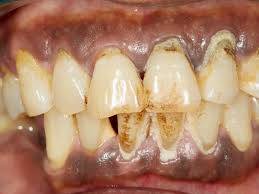Periodontitis is an advanced gum disease that affects the soft tissue and bone supporting the teeth. It often develops from untreated gingivitis and can lead to tooth loss and other health complications. Here is an in-depth look at its causes, signs, effects, and solutions:
---
Causes of Periodontitis
1. Untreated Gingivitis: When gingivitis (gum inflammation) goes untreated, it can progress to periodontitis, where the infection spreads below the gumline.
2. Plaque and Tartar Buildup: Poor oral hygiene leads to plaque buildup, which can harden into tartar (calculus) and harbor bacteria that damage gum and bone tissue.
3. Genetics: A family history of periodontal disease can increase susceptibility, as some individuals are genetically predisposed to gum disease.
4. Smoking and Tobacco Use: Tobacco products can significantly increase the risk of periodontitis by weakening the immune system and delaying healing.
5. Diabetes: Poorly managed diabetes can impair gum health, increasing the risk of periodontitis.
6. Hormonal Changes: Fluctuations in hormones, such as those during pregnancy or menopause, can make gums more vulnerable to infections.
7. Poor Nutrition: Lack of nutrients, especially vitamins C and D, can weaken the immune system and gum tissue.
8. Certain Medications: Drugs that reduce saliva flow, like antihistamines and some antidepressants, can contribute to gum disease by causing dry mouth.
9. Immune System Disorders: Conditions that compromise the immune system, such as HIV/AIDS, increase susceptibility to infections like periodontitis.
---
Signs and Symptoms of Periodontitis
1. Swollen, Red Gums: Gums may appear swollen, red, or purplish.
2. Bleeding Gums: Frequent bleeding during brushing, flossing, or even light pressure.
3. Receding Gums: Gums pull away from the teeth, making teeth look longer and exposing tooth roots.
4. Formation of Deep Pockets: Spaces between the gums and teeth deepen, allowing more plaque and bacteria to accumulate.
5. Bad Breath: Chronic bad breath caused by bacterial infection and gum decay.
6. Loose or Shifting Teeth: Teeth may become loose or shift due to bone and tissue loss.
7. Pus Between Teeth and Gums: An advanced symptom where infected pockets produce pus.
8. Pain When Chewing: Discomfort or pain when biting down, chewing, or applying pressure to teeth.
---
Effects of Periodontitis
1. Tooth Loss: Destruction of the tissue and bone supporting the teeth can lead to tooth mobility and eventual tooth loss.
2. Bone Loss: Periodontitis erodes the jawbone, weakening the structural support for teeth.
3. Abscess Formation: Bacteria can cause painful abscesses in the gums, which may require drainage and antibiotics.
4. Systemic Health Risks: Periodontitis has been linked to systemic health issues, including heart disease, stroke, diabetes complications, and respiratory infections.
5. Gum Recession: Gum recession can lead to exposed roots, increasing sensitivity to temperature changes and making teeth more vulnerable to decay.
6. Higher Treatment Costs: Advanced stages of periodontitis require complex and costly dental treatments like surgery and implants.
7. Impact on Quality of Life: Persistent pain, difficulty chewing, and appearance issues can affect a person’s overall quality of life and self-esteem.
---
Solutions and Treatments for Periodontitis
1. Improved Oral Hygiene:
Brushing and Flossing: Brushing twice daily and flossing at least once a day helps control plaque buildup. Using an electric toothbrush can be even more effective in removing plaque.
Antibacterial Mouthwash: Using an antibacterial mouthwash can help reduce bacteria and inflammation.
2. Professional Dental Cleaning:
Scaling and Root Planing: A deep cleaning procedure where the dentist removes plaque and tartar from below the gumline and smooths the root surfaces to prevent further plaque buildup.
More Frequent Cleanings: Patients with periodontitis may need professional cleanings more often, usually every 3 to 4 months.
3. Antibiotic Therapy:
Topical Antibiotics: Dentists may place antibiotic gels or fibers directly into periodontal pockets to reduce bacterial infection.
Oral Antibiotics: For more severe cases, oral antibiotics may be prescribed to control bacterial infection.
4. Surgical Treatments:
Flap Surgery: In cases where deep pockets have formed, the gums are lifted back for a thorough cleaning, and the tissues are then sutured in place to fit snugly around the tooth.
Bone and Tissue Grafts: Bone grafts and tissue grafts can help regenerate lost bone and tissue and stabilize teeth.
Guided Tissue Regeneration: A procedure where a special membrane is placed between the gum and bone to encourage new bone growth.
5. Laser Therapy:
Laser Treatment: Some dentists use lasers to reduce the size of periodontal pockets and remove infected tissue, although it is not suitable for all cases.
6. Lifestyle Changes:
Quit Smoking: Stopping smoking or tobacco use can greatly improve gum health and help in the healing process.
Manage Diabetes: Proper management of diabetes helps control gum inflammation and infection risk.
Healthy Diet: A diet rich in vitamins, especially C and D, supports gum health and immune response.
7. Regular Dental Visits:
Routine Checkups: Frequent dental checkups allow for early intervention and monitoring, especially for those with a history of gum disease.
8. Stress Management:
Reduce Stress: High stress can impair the immune system, making it harder for the body to fight infection. Managing stress can contribute to better gum health.
---
Periodontitis is preventable and manageable with early intervention, proper oral hygiene, and lifestyle adjustments. Consistent care and regular dental checkups can help prevent progression and maintain oral health, protecting both your teeth and overall health.


